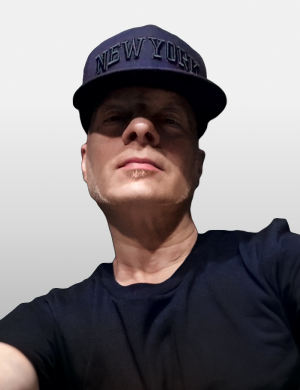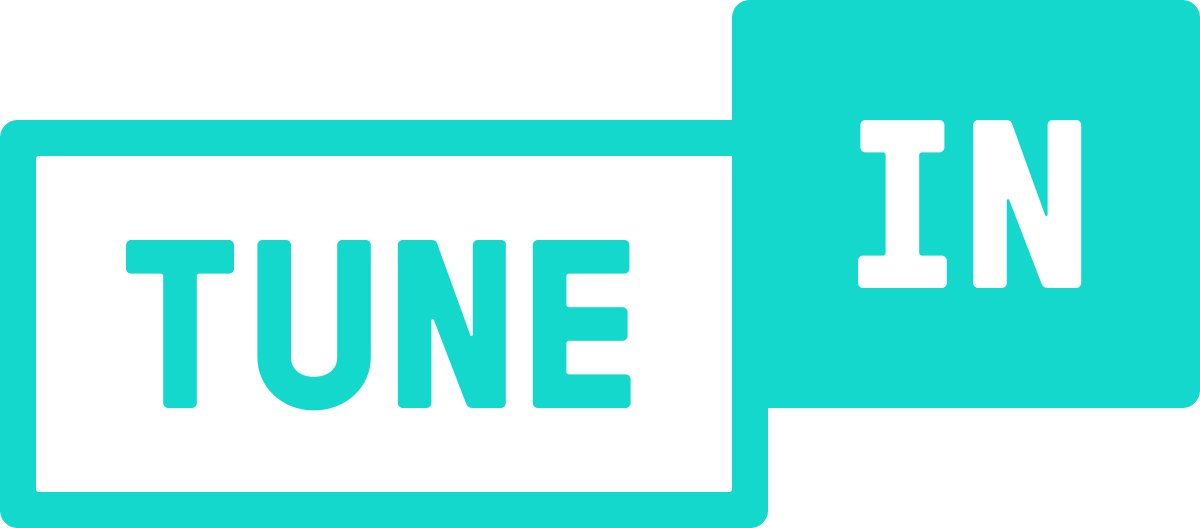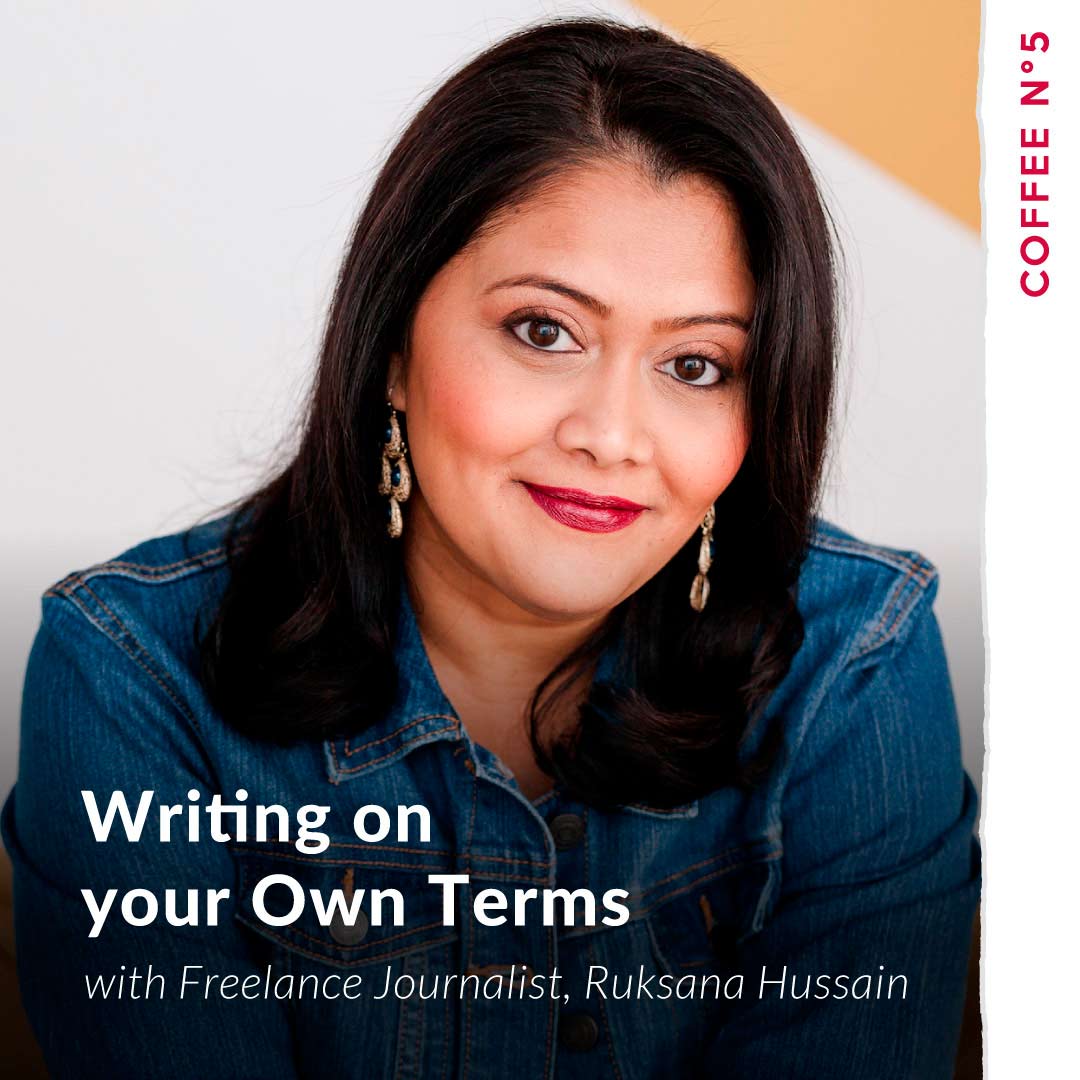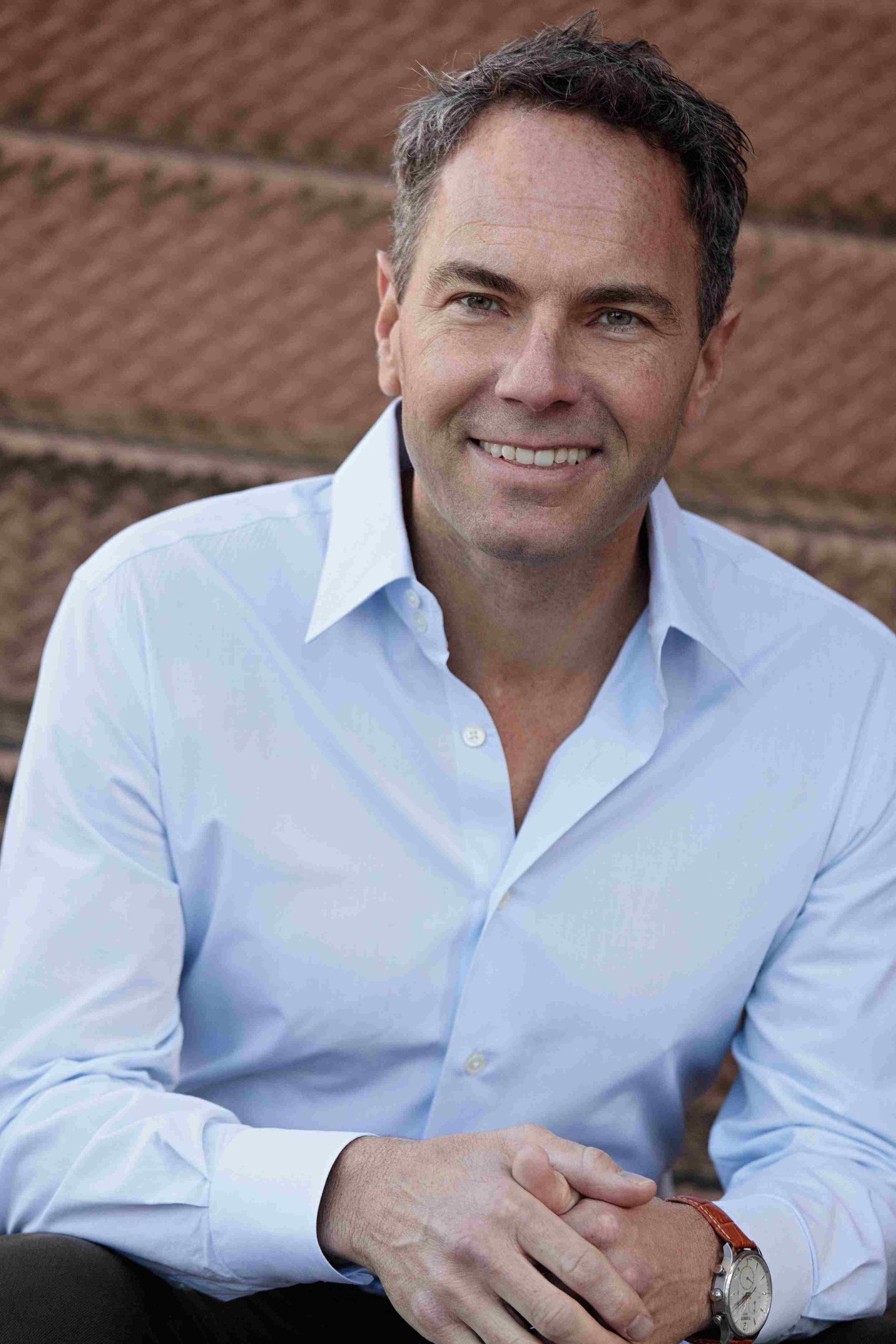Lara Schmoisman (00:11)
Hi everyone, welcome back to coffee number five. well, I’m gonna go back and back and back in time today. Well, my first love was radio and here we are. But my second degree, and I don’t know if you know this about me, is screenwriting, which I never thought it will come back to my life and help me so much.
When I started working in marketing and digital and I found myself trying to write copy for my clients, basically, I was like, okay, I can do that. And I started using my knowledge of how to build a character. And I realized a character, wasn’t the brand. The character actually was my consumer, which I didn’t expect that.
And if you understand your consumer, then you can start writing with an intention how to attract that consumer. But I wanted to take it to the next level today and bring to you someone who specializes in writing, in copy packaging and all across the board. So we can have a really insightful conversation of how important is the copy? Because I think a lot of people are underestimating the written word. So.
Welcome, Carmen. Thank you so much for being here today.
Carmine Montalto (01:33)
Laura, thank you. I’m excited to be here and I love this topic, of course, because it’s near and dear to my heart. I’ve been a writer since I was five years old.
Lara Schmoisman (01:41)
Aren’t we all writers?
Carmine Montalto (01:42)
I hope, but there’s so many people who are so terrified of writing and looking stupid in writing that they they close themselves off to it. Of course, we’re all writers, but some of us are passionate about it and make our living off of it. And, you know, it fuels us. At least it fuels me.
Lara Schmoisman (01:59)
Yeah.
Yeah, I love, I’m super picky. And one of my challenges was when I start writing in English. First of all, writing English is completely different. And everyone who listened to this knows that I’m self-taught. So I never took grammatical classes. So, and you don’t write the same way that you speak. It’s completely different. So it’s like learning a language all over again.
Carmine Montalto (02:16)
Mm.
Right. Yeah.
for sure.
Lara Schmoisman (02:26)
And then to me it’s all about intention. So for you, where do you start when you need to start writing something?
Carmine Montalto (02:29)
Mm-hmm.
You know, the worst thing is starting with a blank page. So, and I think it took me a long time to realize that getting from the blank page to something written on the page doesn’t mean that that something needs to be perfect. You just need to get a foundation. And it’s like a foundation to anything. You know, if you’re making clay, like,
Lara Schmoisman (02:37)
I know.
Carmine Montalto (03:00)
You need to build it into something. If you’re making a house, obviously that’s the easiest analogy. You build the foundation and then you build on top of it. The Statue of Liberty is on a foundation, right? So to me, ⁓ you start with a foundation and then you mold it again like you’re making a beautiful piece of art. That’s what writing is to me.
Lara Schmoisman (03:21)
But I mean, I think with writing for me, sometimes what is hard is where to stop. Because you’re…
Carmine Montalto (03:27)
⁓ guilty, guilty. Every
single paper I ever submitted during my education to every single teacher, it didn’t matter what grade it was from grammar school all the way through college. I got the word wordy in the margin when they handed the paper back.
Lara Schmoisman (03:46)
It’s not about being worldly, it’s about hyper editing yourself.
Carmine Montalto (03:50)
Very difficult. And you know, I learned too that you need what’s termed an incubation period, you know, where you need to separate yourself from your own writing. And you give yourself a day, two days sometimes, and you can come back and it’s like someone else wrote it, right?
Lara Schmoisman (04:07)
Sometimes it even happens to me, like, did I write this?
Carmine Montalto (04:09)
Did I write this? That was just two days ago. Wait a minute, right? So then you can edit it. But that’s such an interesting process where you get so fixated on your own writing that you can’t edit it and you can’t see it objectively until you give yourself some distance.
Lara Schmoisman (04:12)
Yeah.
Yeah, and I always go back to this that I was mentioning before about the consumer. Who is my consumer and how is this connecting with the consumer? And I feel like right now there are a lot of brands and a lot of branding agencies guilty on making everything about the brand. we visually, yes, they are. Yes.
Carmine Montalto (04:39)
Mm-hmm.
Yes, visually, visually, they focused on visual to the detriment of the written word. It
happens every single time. I can’t tell you how many, you know, I work on a lot of consumer brands predominantly in beauty and the brands have paid, I don’t know, 50,000, 100,000, $250,000 to a branding agency to, you know, refresh the brand. And they share the guidelines with me and I’m like,
Where are the guidelines for copywriting? For the voice. And it’s always like maybe one slide, bare bones, nobody really put any thought into it. And I have to fill in the blanks for them or edit it or add those pages.
Lara Schmoisman (05:12)
Exactly!
It’s
so, so sad that we, why you think that happened? mean, I feel like this right now, everything, and that’s what we do at the Darlin. I think we do it really well, which is integrating everything. But right now I see that most agencies are becoming our growth or creative, which is copy mostly, or branding.
Carmine Montalto (05:37)
Mm-hmm.
Mm-hmm.
Yeah.
Lara Schmoisman (05:47)
Why you think that happens?
Carmine Montalto (05:48)
I don’t know, the business really has changed and I understand that creative around branding is dynamic. But if you think about Mad Men, like you’ve watched Mad Men, Like you think about how revered the copy was in Mad Men and Elizabeth Moss was the copywriter and what she created was just as important and maybe even more important than what the image was in the ad.
Um, they were, they were of equal weight. And when I, you know, I was in house at Kiehl’s for seven years and I was ironically their first ever copywriter in 150 years, they never had a copywriter. And at Kiehl’s at least the, the visual element and the verbal element, the written and the visual were, were of equal weight. And I always, I always really appreciated that not just because I was the head of copy and
you I want it to feel important, but because to your point, it’s important for the consumer that a brand is speaking to them and not proverbially, but literally.
Lara Schmoisman (06:54)
Yeah. I mean, we do this all the time. Like for example, email marketing. What is going to make you open an email? Not amazing graphics, just a subject line.
Carmine Montalto (06:59)
Mm-hmm.
a subject line, isn’t that crazy? A five word subject line. That makes you open, you’d think everybody would get that. That means everything. And you know, I’m really big when I have to work on, you know, have multiple clients and sometimes clients need me to write consumer emails. And I’m really big on the synergy between the subject line and the preview header. You know, that little line right below it. You can link those up and pair that up and that’s what you use to
Lara Schmoisman (07:08)
Yeah.
Yeah.
Absolutely.
Storytelling!
It’s all storytelling!
Carmine Montalto (07:33)
Yeah, that’s exactly you
lure the consumer in that way.
Lara Schmoisman (07:38)
But then you go into the email and then that storytelling, the narrative needs to be continued, but also.
Carmine Montalto (07:44)
Yeah, I look at every single one as an ad. Every single
email should feel like an ad.
Lara Schmoisman (07:49)
But that’s something also I talk to my design team all the time, a multimedia team. Guys, use the written word. They’re giving you the clues of where to start with the design. You’re not starting with a white canvas in design because you having the thing in me, they telling you, read, don’t just slap pictures. And I feel like that’s a lot of friends that come to me and they tell me email marketing doesn’t work is because…
Carmine Montalto (08:03)
Yes, true, yeah.
You’re not working it right. Yeah.
Lara Schmoisman (08:17)
You’re not doing it right.
The same way if you tell me social media doesn’t work, it’s because you’re not doing it right. You need to know the magic of each channel.
Carmine Montalto (08:23)
For sure.
Yeah, yeah. And they’re distinct. Each of each is distinctive.
Lara Schmoisman (08:30)
Yeah, I have a question for you. This is going to be a little controversial.
Carmine Montalto (08:32)
Yes. Mm-hmm. Okay. I love controversy.
If you follow my blog, you know I love controversy. ⁓
Lara Schmoisman (08:38)
Yes, I do. Let’s
talk about AI for a minute and how is it changing the industry and how they change you.
Carmine Montalto (08:43)
Okay.
Yeah.
Well, I’ll tell you, you I don’t know if you’re familiar with, God, what’s his name? The professor of branding at NYU, Scott Galloway. And so, you know, he does a technology podcast, a couple of them in fact, but one of them is called Pivot. ⁓ And they talk a lot about AI and I love podcasts.
Lara Schmoisman (08:56)
I’m freely bad with men. ⁓ Okay.
Carmine Montalto (09:11)
I ride across Brooklyn every morning 15 miles, sometimes more. It’s like an hour and 20 minutes. And I love to be immersed in a podcast while I’m doing it. And so I remember very distinctly listening to this one podcast and it was about three or four months after ChatGPT launched. And it was like this big hoopla. What is this going to do? Everybody’s threatened by it and writers are threatened by it and all of this stuff. And he said, you know,
Lara Schmoisman (09:30)
Mm-hmm.
Carmine Montalto (09:38)
And again, he’s a professor of branding at NYU. You know, the danger to writers is not. AI. The danger to a writer is another writer who knows how to use AI to better their own writing. And I use AI every single day. I use either chat, GPT or perplexity every single day.
Lara Schmoisman (09:42)
Mm-hmm.
Yes.
I use so much AI. me, talking about AI is like three years behind. I mean, it’s a talk that I had a long time ago. I was using it from the beginning and I feel like we don’t adapt to use AI. We are behind.
Carmine Montalto (10:13)
Yeah.
I look at it as a tool. When I was at Kiehl’s, I had a copywriter reporting to me. He was outstanding. And again, back to that white space, the white canvas, I would say to him, can you work on this first? Work on this first. We would ideate around it. You get started with it. And then I’ll handle it and finesse it and all of that.
Lara Schmoisman (10:32)
Yeah.
Carmine Montalto (10:44)
And, you know, we worked in tandem. were like a right and left arm of each other. And I don’t have that now because I’m out doing my own thing. And I look at an AI as a tool to help, you know, move me forward, break through ideas, do research for me, like just asking what are peptides? What’s the molecular weight of peptides in Daltons?
Lara Schmoisman (11:02)
Absolutely.
Carmine Montalto (11:09)
What are the imp of a specific peptide? What are the implications of that? Can it penetrate the skin barrier? If it penetrates the skin barrier, what does it do? And, know, perplexity will give me this whole dossier that’s supported by all of this evidence from all of these sources. And there you go. And then I can use that as a tool to write from and, you know, inform my blog.
Lara Schmoisman (11:28)
Yeah, no, I mean, I use it all the time as well. I encourage my team to use it. I’m not afraid of AI. think you need to use it as a team player, as a team member.
Carmine Montalto (11:31)
Yeah.
Mm-hmm. You shouldn’t be, yeah.
Yeah, absolutely. That’s exactly the way to look at it.
Lara Schmoisman (11:45)
So what’s the difference for you and or not the difference because for example, to me, when you creating a narrative of a brand and that’s what you said before and that’s what worries me sometimes that the branding it has not written words and so much even what it goes into the packaging is the brand voice.
Carmine Montalto (11:48)
Mm-hmm.
Mm-hmm.
Yeah, absolutely.
Lara Schmoisman (12:11)
So how
do you connect the brand voice from a packaging perspective, website, email, and you make sure that it’s omnichannel and the same voice works around in all platforms?
Carmine Montalto (12:23)
Well, you probably will agree with me on this and a lot of people will be like, of course he’s gonna say that, but you need to use the same writer for all of those things. Right? Like it is very challenging for one particular writer to pick up the same cadence as another writer and carry it through.
Lara Schmoisman (12:34)
I
Carmine Montalto (12:46)
all materials on a particular campaign or if you’re doing brand identity, if they work on it in tandem, fine. But if you have one writer owning the voice, then you get to that.
Lara Schmoisman (12:47)
Fuck!
I think
that’s, I think more than one writer for me is about the head writer and how it created that brand voice. And if there is a good job done in how the brand voice is and what words we use and what, like when I create brand voice and I do that, most of my clients come without the brand voice, come with a branding.
Carmine Montalto (13:13)
Mm-hmm.
for sure. Yeah.
Lara Schmoisman (13:21)
So the first thing I do is I create a very lengthy document. Okay. This is your brand voice. When you sign up on this, this is it. It’s the same that your color palette, why we go to the color palette, we have a font, all that, and we don’t have a brand voice. So, and from that brand voice, we do something at the download that we call the Bible. So we call it the client Bible and ⁓ we found out that this word is not something we want to use. So we keep adding.
Carmine Montalto (13:29)
Yes.
Yep. Yeah, for sure.
Mm-hmm.
Lara Schmoisman (13:49)
So every finding we keep adding to the Bible. Yes, yes, because sometimes happens and sometimes like writers, we get carried away. And then we have the graphic designer that they say, hey, this is too long. How can we shorten it?
Carmine Montalto (13:52)
A live document. I love that. Yeah.
my God, I just went through that. I just went through that with a brand, I won’t say who. And actually, it’s you know, they’re just not they’re not sophisticated in brand voice, and they’ve never worked. They’ve never worked with an expert in brand voice before. And, you know, it’s not unlike, honestly, the way Kiehl’s was when I first started word. Again, there was no copywriter for 150 years. Who was writing the copy? Everybody was writing the copy.
Lara Schmoisman (14:08)
Tell me about it Tell me about it
Carmine Montalto (14:34)
which is why the Kiehl’s brand voice was so quirky, which is fine, right? It was organic that way. ⁓ But there’s just a lot of really fun feedback I get on the copy. We’re working on packaging and they don’t want one panel on the packaging is empty. And they are
Lara Schmoisman (14:39)
Mm-hmm.
Carmine Montalto (14:59)
disturbed by that somehow. It’s unsettling that a panel is empty. Can you write something for the panel? And I’m like, what? Just to fill the panel? Just write something to fill the panel.
Lara Schmoisman (15:06)
That’s
Yeah, no,
that’s a must in graphing design to me or packaging design. Learn how to deal with the blanks.
Carmine Montalto (15:13)
Yeah,
absolutely. And I said, well, how does that serve the consumer? Because you’re asking the consumer who’s standing in a Sephora picking this up, you’re asking her to read the copy on that panel. Does she need to read the copy on that panel? There’s copy on other panels that is more important for that product and for the brand itself. So it was just a fascinating exercise, right?
Lara Schmoisman (15:37)
Well,
I have another thing that I do with my team and anyone in my team will quote me when I say that is, is content with intention. Every content has an intention. You cannot break down, put a big font, little font in when it’s the same sentence. I’m giving an intention with this message. You cannot break the format. Even aesthetically it’s pleasing.
Carmine Montalto (15:47)
Yes.
Mm-hmm.
Yeah.
Yeah, absolutely. And you have to always remember the end consumer. Again, you’re having a conversation with them. Every single piece of that package is the brand speaking to the consumer and she’s hearing it. And what is she hearing? Standing in Sephora surrounded by 10,000 other products.
Lara Schmoisman (16:09)
Exactly.
I think
I think anyone at our point in life in maybe grammar school, I don’t know when, probably me, many years ago, we did this exercise of that they change the commas or the period or they remove all of them. you done that? Okay, well, they say it, I’ll find it and I’ll send it to you, but it’s like a sentence that they remove all the periods and the commas and they tell you, put the periods and the commas and depends on how you put it.
Carmine Montalto (16:31)
Mm-hmm.
No
Mm-hmm.
Lara Schmoisman (16:50)
the sentence is completely different, meaning.
Carmine Montalto (16:53)
That’s,
that is wild. I love that. You know, I’m studying, I’m studying Japanese and the Japanese use very few, very little punctuation and they use no spaces in between words. The words all just run on. And interestingly, it’s kind of the same thing. Like if you looked at English, you could read a sentence in English with no spaces between the words.
Lara Schmoisman (16:58)
⁓
Yeah.
Yeah, but our commas and everything give you intentions. In Spanish, even we have the accent that depends of where you use the accent on the word can be different things. ⁓ So it’s so interesting that then we use, and everybody learned that, but then when we go into the design phase, many times we get over creative and we’re breaking the messaging.
Carmine Montalto (17:21)
Yes.
on the word? Yeah. Yeah, for sure.
Mm-hmm.
Lara Schmoisman (17:45)
There’s any time that you think that it’s okay to break a sentence, a grammatically correct sentence.
Carmine Montalto (17:53)
to make it ungrammatically correct?
Lara Schmoisman (17:55)
Yes, or to make it more fun visually.
Carmine Montalto (17:58)
Yeah, I’ve been in that situation. Absolutely. Because I think to, you know, and I always think that my high school English teacher is rolling over in her grave when I do that kind of thing. But, you know, I’m not out here teaching English grammar. I’m out here helping brands sell products.
Lara Schmoisman (18:01)
For example.
And how do you feel about the language evolving? And it’s not necessarily the most British Academy or English Academy and with all these LOL and et cetera.
Carmine Montalto (18:27)
Mm-hmm.
I don’t, mean, I’m a linguist. I’ve studied so many languages. I studied Latin for six years, four years in high school, two years in college. I’ve studied French, English, obviously, Spanish. Now I’m studying Japanese. When I was growing up, when I was a teenager, I taught myself how to read Cyrillic and Greek. And I love the dynamism of language.
Lara Schmoisman (18:52)
Wow.
Carmine Montalto (18:56)
And I understand a language like French that doesn’t allow words in without them being approved by the Academy Francaise. I understand that, but that’s not English. English is many languages brought into the one language. English is based in German, Latin, and all kinds of other foreign loanwords.
So English to me isn’t a static language. I love that the English language is constantly evolving.
Lara Schmoisman (19:26)
Yeah, but it’s very interesting. Every time that I go back to Argentina or talking to friends in Argentina, I can tell you that there are new expressions or that I don’t understand what they mean. And I feel, my God, I don’t speak the same language. I always say one of the hardest thing for me to learn English was the humor, to understand the humor.
Carmine Montalto (19:34)
yeah, that’s great.
That’s amazing!
That’s so amazing.
Humor is the hardest thing to understand in any foreign language. Yeah.
Lara Schmoisman (19:55)
I know. And
I can say that they can only understand a language when you can laugh in that language.
Carmine Montalto (20:01)
Absolutely. I remember
the first time I told a joke in a foreign language. It was in French class in college. And it was the first time I ever told a joke in another language outside of English. And I was so proud of myself because I understood that. Like, that’s the hardest thing to do because it, you know, it’s about it’s about stretching the language itself into a place where you you really need to understand the nuances of a language in order to do that.
Lara Schmoisman (20:12)
I know.
not only stretching
Not only the nuances, you need to understand the culture and what the culture is about.
Carmine Montalto (20:31)
Yeah, absolutely.
Well, the language is a reflection of the culture, right? And you know what’s so interesting about studying Japanese? When you study Japanese and you’re studying in a school setting, that Japanese you’re learning is not the Japanese you’re going to listen to in a TV show, particularly a reality show. And I only discovered that, you know, I thought, ⁓ a lot of people learn languages by watching TV. So let me let me reinforce
Lara Schmoisman (20:35)
Yeah.
Hmm.
Carmine Montalto (20:57)
what I’ve learned in Japanese class by watching reality TV in Japan, from Japan. And they were speaking something completely different. I could barely understand 1%. Like it was like every couple minutes I would understand something they said.
Lara Schmoisman (21:04)
Mm-hmm.
Yeah, think it’s the same for Chinese is that depends of how you say things is completely different.
Carmine Montalto (21:17)
Yes.
Yes, depending on the situation and who you’re with and there’s different like hierarchies to the language. Yeah, I was so I was like, you know, English isn’t really like that, right? We just it’s the same for everybody.
Lara Schmoisman (21:24)
Mm-hmm. Yes.
No, but it’s
very, I have to tell you there are some sounds in English that they are not natural to other cultures.
Carmine Montalto (21:40)
huh, of course, like.
Lara Schmoisman (21:42)
this is a fun one, if you want to have one. I was talking to someone very early when I came to this country and I was saying that it wasn’t something, it’s not in my butt head.
Carmine Montalto (21:44)
You
Lara Schmoisman (21:55)
I was trying to say budget. Budget. It’s ⁓ not a natural sound. the person thought I was ⁓ telling him there was a bad head.
Carmine Montalto (21:55)
Say it again. ⁓ right, the j, right.
Yeah, I thought you said butt head too. So I stopped as well. Like what? Butt head? Yeah, that’s wild.
Lara Schmoisman (22:09)
Yeah. Yes, exactly. ⁓
The word focus could be very interesting if you don’t say… ⁓ yes. Those are very interesting ones.
Carmine Montalto (22:18)
Totally, you really need to stress the O, focus. Yeah, yeah.
Yeah, that’s cool. Language is amazing.
Lara Schmoisman (22:30)
It is amazing and it’s amazing to be able to play with the language.
Carmine Montalto (22:34)
Yeah, I’ll tell you, you know, the best thing that I ever did ⁓ to inform my writing in English as a copywriter was to teach English to foreign students. When I was in LA, I taught ESL and most of my students were Japanese. ⁓ And it taught me because I had to explain so many things that I never had to think of before.
Lara Schmoisman (22:47)
Hmm.
It was the same for me. mean, I started working in digital marketing so early on that was basically no other digital marketing. was Dial-Up. Teaching to my students at the Cal Poly Digital Marketing was, okay, how to think, how to explain this and for them to understand it. So you become to think, to start thinking deeper about what you do and how you do it.
Carmine Montalto (23:03)
Mm-hmm.
Right. Right.
Mm-hmm.
Yeah,
yes, the craziest thing, of course I know now because I’m studying Japanese now for two and a half years, the craziest thing was getting them to understand why and when to use a, an, and the. Because they don’t, those three, that concept really doesn’t exist in Japanese.
Lara Schmoisman (23:38)
Mm-hmm.
No, on, on, ⁓
on, at, also those are different. All prepositions are hard, and I think they’re hard in Spanish, they’re hard too.
Carmine Montalto (23:45)
yeah, of course, all prepositions. Yeah.
They’re hard in every language, but the Japanese at least have at and on and of, they have those, but they don’t have an equivalent for a, an and the. And you know, when I talk about, when you talk about in English, I had an apple, the apple was rotten, or I ate an apple, the apple was rotten. Like for me to have to explain to them why all of a sudden I changed from using an to the.
Lara Schmoisman (24:01)
Mmm.
Carmine Montalto (24:19)
It was so befuddling. I had never thought about why you do that. You just do it.
Lara Schmoisman (24:22)
Well, but it’s the same
in Spanish and we’re making this a linguistic podcast. But it’s like, how old are you? And in Spanish is how many years you have? Which is very interesting, but let’s go back to our life and our professional life. Yeah. So let’s focus for a minute about something very interesting that in our world, we call it direct response.
Carmine Montalto (24:27)
We are. Yeah, it’s true.
Mm-hmm.
Yes.
Go back. We digressed. We digressed. It’s okay.
Mm-hmm.
Lara Schmoisman (24:51)
which to me is a skill. Not every writer has this skill. What is direct response?
Carmine Montalto (24:55)
Mm-hmm.
I don’t know. I’ve never worked in direct response marketing. Is that what you mean?
Lara Schmoisman (25:01)
Well,
it’s direct response writings mostly. It’s like communication through our channels that is going to create an action. Like when you do email marketing, you write direct response. So you’re doing it already. Yes. So SMS marketing is a completely different skill that… Yes.
Carmine Montalto (25:06)
Yeah.
Okay.
Correct, yes. Yes, I’m doing it already, but I just don’t use the language for it.
completely, yeah.
Lara Schmoisman (25:28)
And it’s a skill that I think that not a lot of people are, and this is a whole new term. It’s been around only for a few years. ⁓ and, it’s necessary because we need to use different tools and different elements. Like we were talking subject line, preview line, you need to know all those elements where a CPA is going to go in the case that you’re writing ads. You need to be writing, why you the ad for, for what platform you need to.
Carmine Montalto (25:46)
Yeah. Yeah.
Lara Schmoisman (25:57)
implement all these technical elements into writing. how do you… Why?
Carmine Montalto (26:01)
Yeah, SMS is fascinating to me because I mean, I’m a consumer, right? And when a brand texts
me, I’m like, ⁓ God, what? Right? And I think most consumers, when I write an SMS for a brand, I think most consumers are thinking the same thing. But hopefully enough of them are receptive to it. And you know, I realize I’ve opted in.
Lara Schmoisman (26:17)
⁓
Well, I
think we know too much. I think we know too much to be a typical consumer.
Carmine Montalto (26:26)
I think so too. That’s so true.
That’s the reason why I don’t
have my own skincare brand. I know too much.
Lara Schmoisman (26:35)
And
exactly. And I wish I knew that before, but anyway, ⁓ no, the question is it’s fun because if you are like me, I subscribe to everything because I want to see what other people are doing. So I think we get a lot more messages than normal people.
Carmine Montalto (26:50)
Me too. Yeah, that’s true.
You might,
so I’m hoping I’m not horrifying anybody then, you know, ruining their day. God, that brand again.
Lara Schmoisman (27:00)
Yeah, no, I mean, we love you all, you guys. Well, Carmine, thank you so much for having coffee with me. This was really, really fun. And I hope you guys out there, I’m sure they have a good time with us.
Carmine Montalto (27:03)
Hahaha
Thank you, Laura.
Lara Schmoisman (27:12)
And to you out there, I will see you next week with more Coffee No. 5.








